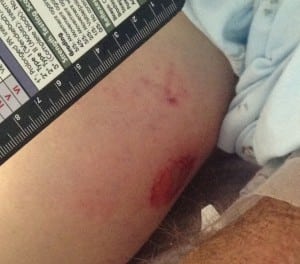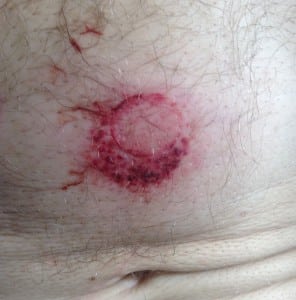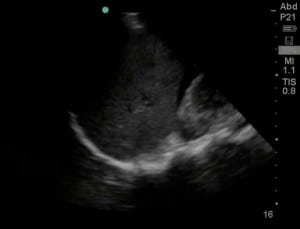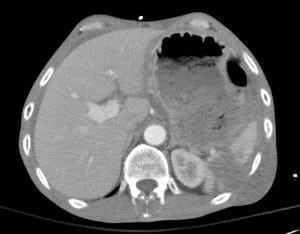| Author | Affiliation |
|---|---|
| Amar Patel, MD | Pennsylvania State University, College of Medicine, Hershey, Pennsylvania |
| Shannon Toohey, MD | University of California Irvine Medical Center, Department of Emergency Medicine, Orange, California |
| Megan Boysen-Osborn, MD | University of California Irvine Medical Center, Department of Emergency Medicine, Orange, California |
CASE REPORT
A 58-year-old male with schizophrenia presented to the emergency department after being shot by law enforcement with two bean bag rounds. He was shot once in the upper abdomen. He reportedly turned and was shot again in the left flank; both shots were at an estimated distance of twenty feet. On arrival, the patient’s blood pressure was 84/52 and heart rate was 121 beats per minute. The patient was agitated and given 5mg intramuscular (IM) haloperidol, 50 mg IM diphenhydramine, and 1 mg intravenous lorazepam. The patient’s chest and back exam revealed a 2.5 cm abrasion and contusion to the left flank (Figure 1). His lung examination was normal. His abdomen was thin, soft, and non-tender. He had another 2.5 cm circular abrasion to the upper abdomen/epigastrum (Figure 2). Initial hemoglobin was 13.4 g/dL. We performed Focused Assessment with Sonography for Trauma examination, which demonstrated free fluid in Morison’s pouch (Figure 3) and the suprapubic window. The splenorenal space did not show any fluid.

Left flank abrasion/hematoma from bean bag round.

Abdominal wall abrasion/hematoma from bean bag round.

Focused Assessment with Sonography examination demonstrating free fluid in Morison’s pouch.
Computed tomography of the abdomen and pelvis with intravenous contrast revealed the following: a moderately displaced fracture of the left 11th rib, buckle fracture of the left 12th rib, trace left anterior inferior pneumothorax, American Association for the Surgery of Trauma grade 4 splenic laceration (Figure 4) with moderate perisplenic hematoma, mild perihepatic hematoma, and anterior abdominal wall/rectus sheath hematoma.

Computed tomography showing grade IV splenic laceration.
DISCUSSION
The use of bean bags as a less lethal technology to apprehend suspects has steadily increased since their introduction in 1994.1 Even though fatalities are uncommon, morbidity and mortality from bean bag weapons was predicted by United States Army studies in 1974, which showed that the impact was significant enough to cause internal organ injuries.2
Previous case series have demonstrated a variety of injuries caused by these less lethal weapons, including: epidural hematoma3, penetrating abdominal and thoracic wounds4,5, hemothorax/pneumothorax, splenic laceration, testicular fracture, globe rupture, orbital fracture, compartment syndrome, and cardiac contusion, among others.1 There have been at least three fatalities reported in the literature and news.1,6,7 The majority of patients injured by bean bag rounds are those with psychiatric disorders.1 Patients often present with an underwhelming physical examination.1 The emergency physician should have a high index of suspicion for serious injuries in patients with bean bag injuries, even in the absence of significant physical examination findings.
Footnotes
Address for Correspondence: Megan Boysen-Osborn, MD. Department of Emergency Medicine, University of California Medical Center, 101 The City Drive, Rte. 128-01, Orange, CA 92868. Email: mbo@uci.edu. 3 / 2014; 15:118 – 119
Submission history: Revision received October 3, 2013; Accepted October 21, 2013
Conflicts of Interest: By the WestJEM article submission agreement, all authors are required to disclose all affiliations, funding sources and financial or management relationships that could be perceived as potential sources of bias. The authors disclosed none.
REFERENCES
1 Brito D, Challoner KR, Sehgal A The Injury Pattern of a New Law Enforcement Weapon: The Police Bean Bag. Ann Emerg Med. 2001; 38:383-390
2 Shank EB, Thein BK, Campbell D . A comparison of various less lethal projectiles. 1974;
3 Drazin D, Shirzadi A, Hanna G Epidural hematoma and surgical evacuation from a bean bag weapon. Am Surg. 2012; 78:E33-35
4 Charles A, Asensio J, Forno W Penetrating bean bag injury: Intrathoracic complication of a nonlethal weapon. J Trauma. 2002; 53:997-1000
5 Olivas T, Jones B, Canulla M Abdominal wall penetration by a police “bean bag”. Am Surg. 2001; 67:407-409
6 Autopsy: Bean bag rounds fired by police killed Park Forest 95. Chicago Tribune. 2013;
7 Columbus officers cleared in bean bag death. Athens Banner-Herald. 2005;


